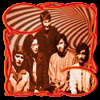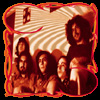Laghonia's 1972 album "Etcetera" combined outstanding music and cutting edge production in a way that foreshadowed Pink Floyd's "Dark Side Of The Moon" — an amazing achievement in a country that was tightly controlled by a military dictatorship at the time. Featuring creative, English language lyrics and dynamic songs influenced by the best bands of the era, their richly textured, intensely psychedelic sound is primed for discovery by new generations of music lovers around the world.
 |
New Juggler Sound was formed in 1965 by brothers Saul Cornejo and Manuel Cornejo in Lima, the largest city and capital of Peru. Saul sang and played guitar, and had studied violin and piano since age 9 at the National Conservatory of Music. His brother Manuel began playing drums on a homemade kit, and Saul helped their childhood friend Eddy Zarauz build a bass guitar. Inspired by The Beatles, they formed New Juggler Sound in 1965 with guitarist Alberto Miller and percussionist Alex Abad. |
With early British Invasion influences like The Kinks, The Animals and The Rolling Stones, they wrote more than a hundred songs in three years while appearing in concerts, theatres, schools, exhibitions, happenings, art galleries and TV shows. Their music, clothes and long hair made them stand out from other Peruvian bands of the day, and they quickly drew media attention. Local record label FTA released their debut single in 1968, featuring "Baby Baby" and "I Must Go". Distributed by RCA, both songs were melodic Beatlesque pop, and they soon followed it with their only Spanish language single, "Sonrisa De Cristal" (Crystal Smile).
The Cornejos wanted to explore adventurous new sounds and Alberto left the band at the end of 1968, opening the door for American guitar prodigy David Levene. Moving to Lima at age 16 with his family, David hitchhiked to northern Peru with his acoustic guitar. Playing songs on a park bench, he drew the interest of Eddy Zarauz who happened to be walking by. David was asked to audition for the band and blew everyone away with his bluesy, psychedelic guitar solos. Inspired by Hendrix and Clapton, he was exactly what they were looking for to give their songs new dynamics. Their musical horizons were rapidly growing, and with the introduction of David's blistering lead guitar skills, the band's chemistry was explosive!
| For the release of their third single in November 1969, New Juggler Sound teamed up with one of Peru's biggest labels, MAG Records. Featuring wild guitars and rock vocals on "Billy Morsa" and "Glue", it was a huge leap forward. They soon added talented pianist Carlos Salom on the Hammond B-2 to complete their immersive sound, becoming the first South American band to feature a Hammond organ. Meanwhile, David's role expanded to include singing and co-writing on several songs and handling many of the lead vocals in concert. |
|
 |
After releasing two more singles, 1970's "The Sand Man" followed by "And I Saw Her Walking", Alex left the band and they decided to change their name to Laghonia. A contraction of La Agonia (The Agony), it reflected internal band tensions that they were experiencing. MAG released the first Laghonia album "Glue" in June 1971, a compilation of the recent New Juggler Sound singles with the addition of two new songs and organ overdubs on the title track. Their next single "World Full Of Nuts" pushed the bounds of psychedelia with lysergic fuzz guitars and demented vocals that sounded like they were being sung underwater on an alien planet. |
Laghonia recorded their second album in late 1971. Eddy left for Bolivia partway through the sessions, so Manuel played bass on three of the remaining songs and Ernesto Samamé joined in time to play on two others. "Etcetera" was released in December, featuring epic songs with complex arrangements, unusual time signatures, sophisticated production and impressive sound quality, capped with a remarkable psychedelic cover collage by Manuel. Full of forward thinking elements that evoke Pink Floyd and Radiohead at times, "Etcetera" is truly a lost classic of Peruvian grandeur.
| Unfortunately, it also marked the end of Laghonia, with David returning to the United States and the rest of the band rebranding under the name We All Together with singer Carlos Guerrero, who had contributed some of the harmony vocals on "Etcetera". Two unreleased Laghonia songs were recorded for We All Together's 1972 self-titled first album, including "It's A Sin To Go Away" which had been written about David's pending departure. Over thirty years later, David and the Cornejo brothers completed two more unreleased Laghonia compositions, the superb "Bengal Tiger" and "No Solution". Recorded in 2004 using their vintage gear, the songs were featured as bonus tracks for a deluxe edition of "Etcetera" that was issued by German label World In Sound. |
All material on this site copyright © Laghonia.com . All rights reserved.
|